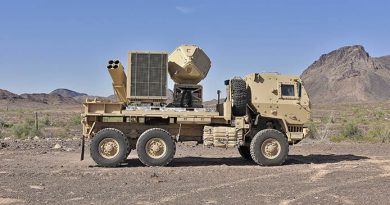PAS 2025 – VSHORAD: Raytheon details the status of existing and new products, and looks at widening its footprint in Europe
At the Paris Air Show Raytheon updated media on its land-based air defence systems, as well as on its increasing presence in Europe. Some systems are emerging while other, such as the Stinger, had a boost due to the Russia-Ukraine war, new missiles being under development
The company developed an array of systems that allow it to propose to its customers a layered and integrated architecture, “and what we are finding over and over again is that such an architecture is the appropriate way to defend a country,” Tom Laliberty, Raytheon President for Land and Air Defense Systems said in his opening remarks.
He then went through the whole Raytheon portfolio, adding interesting figures in terms of shootdowns, most of them carried out in operational theatres.
The shortest-range system is the LIDS (Low, slow, small, unmanned aircraft Integrated Defeat System) based on a radar sensor, the KuRFS (Ku-band Radio Frequency Sensor) which is able to discriminate between small UAVs and birds, a key feature to reduce the false alarm rate. The effector is the well-known 5.9 kg Coyote killer UAV that carries a 1.8 kg blast fragmentation warhead. According to data provided, the LIDS defeated over 170 drones in the hands of the US Army, Qatar being the first export customer. Laliberty highlighted that the Coyote is now used on US Navy destroyers deployed in the Red Sea.
Beside the hard-kill Coyote a soft-kill version has been developed, which in place of the warhead carries a n electronic effector that makes it capable to engage swarms of attacking drones. No details were unveiled on the type of electromagnetic system used, the Raytheon representative saying that “in recent testing, we have had one single Coyote taking out double-digit UAVs all at the same time, all in one mission.” Another advantage of the soft kill version, which uses an electric motor with propeller versus the jet engine used by the hard kill Coyote Block II, is that it is reusable, a quick turnaround to replace or recharge batteries making it ready for the following mission.
Production is a key issue with one-shot systems; “We were building 40 Coyotes a month, we are now at 100 a month, and we will be at 120 a month by the end of the year, and we have plans to continue to scale that as demand wants,” Tom Laliberty stated.
Systems that do not have such problems are direct energy ones. Raytheon developed the HELWS (High-Energy Laser Weapon System), a non-kinetic C-UAS solution scalable up to 50 kW. “We are continuing to work with the Army on ensuring that it is not just good capability for shooting down UAS, but also, we have the ability to maintain it in the field. Laser technology essentially requires a clean room environment to build it, and so we’re working on procedures to be able to support that in the field. It is a great technology in terms of its capability, and now we are working on its robustness to make sure it can be used on the battlefield,” the Raytheon representative said. The HELWS has been used by the US Army in the CENTCOM region, totalling over 25,000 operational hours and shooting down more than 400 UAVs, in a mix of tests and operational use.
Moving to a longer-range effector, the ubiquitous Stinger remains the most used VSHORAD shoulder-launched air defence in the western world. This missile saw intensive use in Ukraine, although no figures were provided. “There is significant demand for Stinger, and we have ramping production in our Andover facility.” No numbers were made available on production; “by the end of next year [2026] we will be increasing production by 50% compared to nowadays,” Laliberty said. The Stinger had not been ordered for quite a long period, therefore Raytheon had to bring all its suppliers back online and ramp up production; between 1980 and 2000 the company produced 50,000 Stingers, while between 2000 and 2020 it produced only 13,000 such missiles. “We are really at a stage now where we have ramped up that production, and we are starting to produce missiles,” Tom Laliberty said. Moreover, Raytheon announced the signature of a memorandum of understanding with Germany’s Diehl Defence to co-produce the Stinger in Europe.
With the Stinger picking up pace, it is however time to develop a new effector in the same market segment; the original FIM-92 Stinger was first launched in 1967, and although the most recent versions are in fact a wholly new missile, the project is over 60 years old. Raytheon is working on the NGSRI (Next-Generation Short Range Interceptor), in cooperation with Northrop Grumman. In early June 2025 the two companies announced to have successfully conducted rocket motor tests for the NGSRI programme; this solid rocket motor uses highly loaded grain technology, “and we believe this is the first time it has been used in such a small form factor. The new motor is considered a key element to cope with the higher speed and other improved performance requirements. “The combination of that new propulsion technology plus the advances that we are bringing in the seeker and the control system, will make this new weapon much more capable than Stinger. And it will be much more producible given that we will be using much more modern technology,” Tom Laliberty stated. “The NGSRI is going to have an onboard seeker with a much wider field of view and much longer detection range, while its flight software and control actuation system will make it much more capable in end game dynamics,” he added.
Photos courtesy Raytheon, Northrop Grumman and US Army








